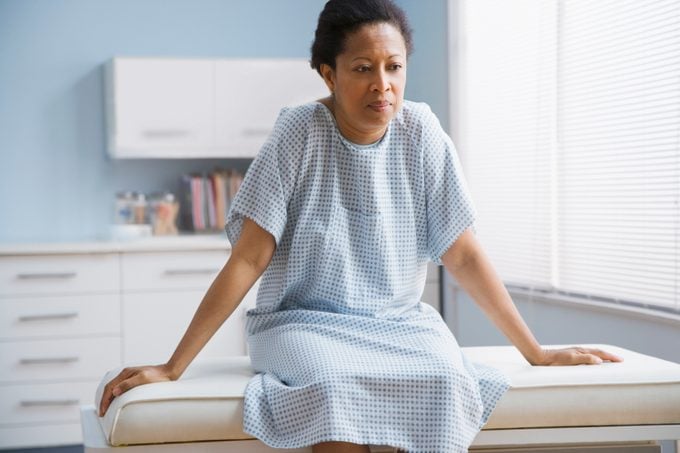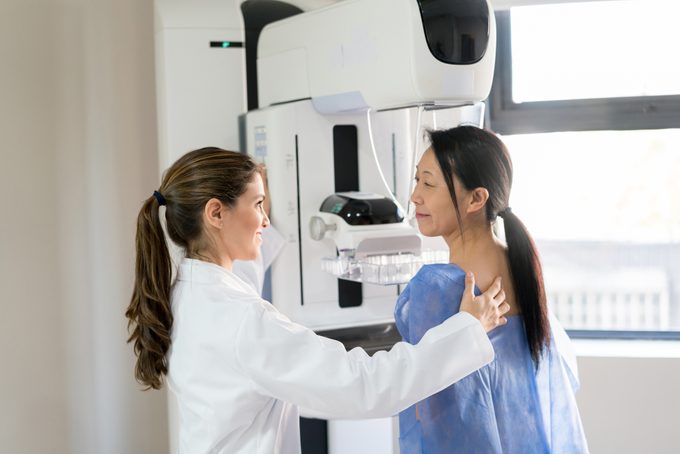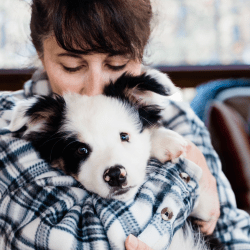Breast Cancer: What Doctors Want You to Know About Symptoms, Treatment, and Prevention
Updated: Oct. 11, 2022
Learn the basics about breast cancer prevention, symptoms, treatment, and care.
For women, it’s hard not to think about breast cancer. Many people know someone who has had it and there are always concerns about what might cause it.
Whether you do monthly self-exams, get regular mammograms, or just want to be smart about what you should know about your breasts, here are the basics about breast cancer prevention, symptoms, treatment, and care.
On This Page
What is breast cancer?
Breast cancer is a disease that starts when cells in the breast begin to grow out of control.
Cancer cells most often form a lump that can sometimes be felt on a self-exam or noticed on a mammogram. Most of these breast growths are benign, meaning they aren’t cancerous.
Breast cancers can start in different parts of the breast. Most start in the ducts that carry milk to the nipple or they begin in the lobules, which are the glands that produce milk. Less common types start in the tissue of the breast. Sometimes breast cancer can spread to other parts of the body and that’s when cancer is said to have metastasized.
Breast cancer is the second most common cancer in women, but men can have breast cancer too. Each year in the U.S., about 250,000 cases of breast cancer are diagnosed in woman and about 2,300 cases are diagnosed in men, according to the Centers for Disease Control and Prevention (CDC).
Symptoms of breast cancer
Early on, breast cancer might not have any symptoms. And some people never show obvious signs of the disease. The most common symptom is a new lump, but not all cancers start that way. That’s why it’s important to regularly examine your breasts so you can quickly notice any unusual changes.
The most common symptoms of breast cancer include:
- New lump in the breast or armpit
- Swelling of part or all of the breast
- Dimpling in the skin that might look like an orange peel
- Breast or nipple pain
- Red, dry, or flaky skin on the breast or around nipple
- Nipple turning inward
- Any change in the shape or size of the breast
- Nipple discharge (other than breast milk)
- Swollen lymph nodes under the arm or around the collar bone
These symptoms can also be signs of other conditions besides breast cancer. Still, if you find any changes in your breast, it’s important that you see your doctor for an exam and tests.
Types of breast cancer
There are many types of breast cancer. They are described as either “invasive” or “noninvasive,” which is also known as “in situ” (a Latin term that basically means “in place”). Invasive cancers spread from the breast ducts or lobules to other parts of the breasts. Noninvasive or in situ cancer has not spread outside its original location.
Invasive ductal carcinoma is the most common type of breast cancer. It starts in the ducts and spreads into other parts of the breast tissue. Invasive lobular carcinoma spreads from the lobules to the breast tissue.
Ductal carcinoma in situ or DCIS is confined to the ducts in the breast and hasn’t spread to surrounding tissue. Lobular carcinoma in situ or LCIS is located in the lobules and also hasn’t spread.
There are several less common types of breast cancer including Paget’s disease, inflammatory breast cancer, Phyllodes tumor, and angiosarcoma.
Breast cancer risk factors
Researchers don’t know what causes breast cancer, but certain factors make you more likely to develop it. Some of them are out of your control—like your age and having a family history of the disease. But some things you can change, like losing weight if you are overweight, limiting alcohol, or quitting smoking.
Risk factors you can’t control
Gender — Being a woman is the main risk factor for developing breast cancer. Based on National Cancer Institute statistics, 12.8 percent of women born in the U.S. today will develop breast cancer at some point in their lives. That means a woman born today has a 1 in 8 chance of being diagnosed with breast cancer in her life. A man born today, on the other hand, will have a 1 in 800 (or 0.13 percent) chance of being diagnosed with breast cancer.
Age — Your risk goes up as you get older. Most breast cancers are found in women over 55.
Family history — Most women who have breast cancer don’t have a family history of the disease. But if you have a close female relative (mother, sister, or daughter) with cancer, that almost doubles your risk. If you have two or more close relatives, your risk is at least three times higher than people who do not.
Personal history — If you’ve already had breast cancer, you’re three to four times more likely to develop it again.
Genes — Women who have inherited changes (mutations) to certain genes, such as BRCA1 and BRCA2, are more likely to develop breast cancer.
Having dense breasts — Dense breast tissue can make mammograms harder to read. People with dense breasts can be twice as likely to develop cancer as people with non-dense breasts.
Menstrual history. Your odds increase if:
- You started your period before age 12
- You didn’t go through menopause until 55 or later
Hormone therapy — Women who took or are currently taking hormone replacement therapy (estrogen and progesterone) after menopause have an increased risk.
Radiation to chest or face — Having radiation therapy to the chest or face for another type of cancer or condition before age 30 can increase your chances of developing breast cancer.
Race and ethnicity — White women are slightly more likely to develop breast cancer than Black, Hispanic, and Asian women. But Black women are more likely to develop aggressive, more advanced-stage disease that is diagnosed at a young age.
Having certain breast conditions — Some benign conditions such as papillomas (growths that can occur in the milk ducts of the breast) or a radial scar (a type of lesion that can look like breast cancer on a mammogram but is not) may raise your chances of being diagnosed with breast cancer. (Although in some cases they may not be associated with higher risk, so talk to your doctor about your particular condition.)
Risk factors you can control
Drinking alcohol — Research consistently links alcohol intake to breast cancer. The risk increases the more you drink.
Being overweight — Older women who are overweight or obese have a higher risk of developing breast cancer.
Not exercising — Exercising helps prevent cancer. In a 2016 meta-analysis of 38 studies, the most active women had up to a 21 percent lower risk of breast cancer than those who were the least active.
Smoking — Breast cancer, like so many diseases, is also linked to smoking.
Reproductive history — Factors related to pregnancy and childbearing also influence cancer risk. Your risk is higher if:
- You have your first child after age 30
- You don’t breastfeed
- You don’t have a full-term pregnancy

How breast cancer is diagnosed
If you notice a change in your breast or if something unusual appears on a mammogram, your doctor will do an exam and possibly order some diagnostic tests to better understand what’s causing your symptoms. These typically include:
Breast ultrasound — This imaging test uses sound waves to make detailed pictures of areas inside the breast. It can help tell the difference between fluid-filled cysts and solid masses.
Mammogram — This is a detailed X-ray of the breast that looks at lumps or other issues.
Magnetic resonance imaging (MRI) — This body scan uses a magnet linked to a computer to make detailed images of areas inside the breast.
Biopsy — For this test, your doctor removes fluid or tissue from your breast to be examined under a microscope. There are different types of breast biopsies. Sometimes your doctor will use a needle to remove the sample and other times they will make a small cut in your breast to remove samples for testing.
How breast cancer staging works
If breast cancer is diagnosed, it is assigned a stage based on characteristics like how big the tumor is and if it has spread. Staging ranges from 0 to 4.
Stage 0 — This is noninvasive or early stage breast cancer with no sign that it has spread from where it started.
Stage 1A — The main tumor is less than 2 cm wide and hasn’t spread to the lymph nodes.
Stage 1B — There are signs of cancer cells in the lymph nodes but there is no actual tumor found in the breasts or if there is one, it’s no bigger than 2 cm (about the size of a peanut).
Stage 2A — There’s no tumor in the breast or the tumor is smaller than 2 cm and the cancer has spread to 1-3 lymph nodes, or the tumor is between 2-5 cm and hasn’t spread to any lymph nodes.
Stage 2B — The tumor is between 2-5 cm and has spread to 1-3 lymph nodes, or the tumor is larger than 5 cm and hasn’t spread to any lymph nodes.
Stage 3A — Cancer of any size that has spread to 4-9 lymph nodes, or a tumor is greater than 5 cm and has spread to 1-3 lymph nodes.
Stage 3B — A tumor has spread to the chest wall or skin and may have spread to up to 9 lymph nodes.
Stage 3C — Cancer has spread to 10 or more lymph nodes, the internal mammary nodes, or lymph nodes under the collarbone.
Stage 4 (metastatic) — Tumors can be of any size and have spread to distant organs or lymph nodes.
Treatments for breast cancer
If tests show that you have breast cancer, you’ll work with your health care team to find the best treatment plan for you. Surgery is one of the most common treatments for breast cancer, but some women also have additional treatments such as chemotherapy or radiation. Here are some options:
Watchful waiting: If you have very early, noninvasive breast cancer—sometimes called stage 0—you may have the option of continued monitoring and testing before making a decision to have more aggressive treatment. This may be an option if you have DCIS or LCIS, and it will help determine how quickly the abnormal cells are growing and whether they are likely to become invasive. It’s an active process and doesn’t mean you aren’t being treated.
Surgery: Surgery is the most common treatment for breast cancer. There are several types:
- Breast-conserving surgery The surgeon removes only the part of the breast that contains the cancer, along with some surrounding tissue. How much they take out depends on things like where and how big the tumor is. Types of this surgery include lumpectomy, quadrantectomy, partial mastectomy, and segmental mastectomy.
- Mastectomy A surgeon removes the entire breast, including sometimes nearby tissue. There are several kinds of mastectomies. Removing both breasts is a double mastectomy.
- Lymph node removal Your doctor might remove lymph nodes if cancer has spread outside the breast.
Radiation therapy: Radiation uses high-energy rays to destroy cancer cells. Traditional radiation uses a machine that transmits radiation from outside your body. With a newer type called brachytherapy, a surgeon places radioactive pellets inside the body that transmit radiation for a while.
Chemotherapy: Cancer-destroying chemotherapy drugs are either injected into your veins via IV or are taken by mouth. It’s often given before or after surgery.
Hormone therapy: Certain cancers grow in response to some hormones. This treatment works by blocking your body’s production of those trigger hormones.
Targeted therapy: These drugs attack specific cancer cells. They usually don’t harm normal cells as much as chemotherapy or radiation.
Immunotherapy: These drugs use your body’s immune system to fight cancer cells.
Clinical trials: These studies look for new and better treatments to fight a disease. You may be among the first to receive a new treatment. Ask your doctor if there is a clinical trial available for breast cancer and whether it would be a good choice for you.
How to prevent breast cancer
There are some risk factors that you can’t avoid, but there are many habits that may help prevent breast cancer.
Lifestyle factors
- Keep a healthy weight
- Exercise regularly
- If you smoke, quit
- Limit or don’t drink alcohol
No foods can prevent or cure breast cancer, but adding certain foods to your diet—like olive oil, salmon, and nuts may help lower your cancer risk.

Screenings and self-exams
Doing monthly breast self exams and having regular mammograms can help find cancer at an early stage. Recommendations for how often you should get a mammogram may depend on your age, family history of cancer, and certain risk factors.
The American Cancer Society recommends:
- Women 40-44: Mammograms are an option, if your doctor thinks you need it
- Women 45-54: Get a mammogram every year
- Women 55-plus: Switch to every other year, or can stay with yearly mammograms
Not all guidelines are the same. The recommendations from the U.S. Preventive Services Task Force, for example, suggest that most women ages 50 to 74 get a mammogram every two years. You may want to consider screenings between 40 and 49 if you and your doctor think you need it.
Genetic testing for breast cancer risk
If you have a history of breast cancer in your family, your doctor might suggest genetic testing to see if you have a genetic mutation—like the BRCA1 or BRCA2 gene mutation—that would increase your chances of developing the disease.
If you have a concerning mutation, talk to your doctor about preventive options. A prophylactic mastectomy, or surgical removal of both breasts, has been found to reduce the risk of breast cancer in high-risk women by about 90 percent, according to the National Cancer Institute.
Personal stories
Stories of people living with breast cancer can help you deal with your own diagnosis. Here are some that show what it’s like to live with this issue.
- What Chemotherapy Is Really Like, According to Cancer Survivors
- These 14 Women Are Grateful for Their BRCA Diagnosis
- How 17 Under-50 Women Learned They Had Breast Cancer
- Why This Woman With Metastatic Breast Cancer Posed as a Mermaid
Additional resources
If you’d like to learn more about breast cancer, here are some additional resources:
